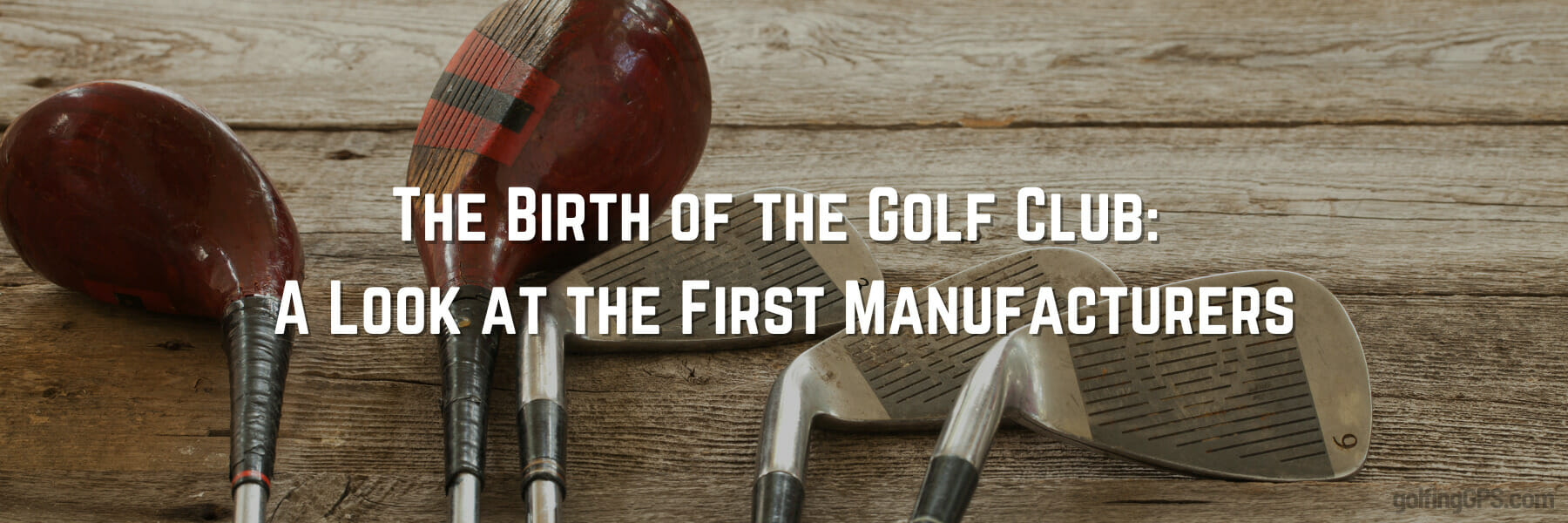Golf Club History: A Look at the First Manufacturers

!!!!DISCLAIMER!!!! This site may contain Amazon & other affiliate links.
This means if you click on one of the product recommendation links, this site may receive a small commission. This is at no extra cost to you and may include exclusive discounts when possible. This helps support this site and allows us to keep making content like this. Thank you for your support!
Discover the origins of golf club manufacturing with this informative post. Learn about the first companies to produce these essential golfing tools.
Golf is a sport that has been around for centuries, with roots dating back to the 15th century in Scotland. As the sport evolved, so did the equipment used to play it. One of the most important pieces of equipment in golf is the club. But have you ever wondered who the first manufacturers of golf clubs were?
In this article, we’ll take a closer look at the first companies to manufacture golf clubs and how their designs have influenced the clubs we use today.
A Short History of Golf Clubs
Golf clubs have changed significantly over the centuries. Initially, golfers used clubs made of hickory wood, which was heavy and difficult to use. Today, golfers can choose from various clubs made from high-tech materials designed to improve distance, accuracy, and playability.
The history of golf clubs dates back to the 15th century when golf was first played in Scotland. The earliest clubs were made from various materials, including wood, iron, and even bone. These clubs were relatively simple, with straight shafts and simple club heads.
Manufacturers began experimenting with new designs and materials as golf became more popular. One of the most significant innovations was the introduction of the steel shaft, which offered greater strength and durability than the traditional wooden shaft.
In the early 20th century, major golf club manufacturers emerged, including Wilson Staff, Cleveland Golf, and Adams Golf. These companies offered a wide range of club designs and materials, catering to golfers of all skill levels.
Today, the market for golf clubs is dominated by a handful of major players, including Callaway Golf and TaylorMade. These companies produce high-quality equipment that professional and amateur golfers use. In recent years, hybrid clubs have become increasingly popular, offering golfers the versatility of fairway woods and irons.
The Role of Blacksmiths in Club Making
Blacksmiths played an essential role in the early days of club making. They were highly skilled craftsmen who were able to shape metal to create club heads that were both durable and functional. Hickory sticks were the preferred material for the shafts, as they were solid and lightweight.
The first records of golf club manufacturing date to the 17th century, where The Musselburgh Golf Club was established. Here, skilled artisans would make wooden clubs by hand.
As golf grew in popularity in the 19th century, so did the demand for high-quality clubs. This led to the developing of new materials and manufacturing techniques, such as steel shafts and machine-made club heads.
Blacksmiths were instrumental in the early days of golf club manufacturing. With their expertise in metalworking, the development of specialized clubs was possible. While modern manufacturing techniques have primarily replaced traditional methods, the legacy of the blacksmiths lives on in the golf clubs we use today.
Early Examples of Blacksmith-Made Clubs

Today, golf club manufacturers like Cleveland Golf, Adams Golf, and Callaway Golf Company offer golf clubs with stainless steel shafts and club heads designed for players of all skill levels. However, the early examples of blacksmith-made clubs still hold a special place in the game’s history and continue to be appreciated by golf enthusiasts worldwide.
The Process of How Blacksmiths Create Golf Clubs:
- To begin with, the blacksmith would select a piece of metal, usually iron or steel, and heat it in a forge until it became red-hot and pliable
- Then, using a hammer and anvil, the blacksmith would shape the metal into the desired form
- Next, the blacksmith would add the finishing touches to the club head. It involves smoothing rough spots or adding decorative elements like grooves or patterns
- The blacksmith would drill a narrow hole into the top of the club head and then insert the shaft into the hole
- Then, the blacksmith would fasten the two pieces together, usually with twine or other binding material
- Finally, the blacksmith would add a grip to the club. It involves wrapping the end of the shaft in leather or adding a rubber grip to the handle
Early Manufacturers of Golf Clubs
In the early days of golf, clubs were made from materials such as wood, ash, and horn. The process of manufacturing was time-consuming and required skilled craftsmen. As the game grew in popularity, many entrepreneurs saw an opportunity to create a profitable business by manufacturing golf clubs.
Here is the list of Early Notable Manufacturers:
1. Edinburgh Golfers
The Edinburgh Golfers were one of the first manufacturers of golf clubs, dating back to the 1700s. They were known for their handcrafted wooden clubs made from hickory and ash. These clubs were famous throughout Scotland and eventually made their way to other parts of the world.
2. Spalding
Spalding is another company that played a significant role in the early days of golf club manufacturing. Founded in 1876, Spalding began producing golf clubs in the late 1800s and quickly became one of the most popular brands in the sport. They were known for their innovative designs and were the first company to introduce the concept of matching sets of clubs.
3. Tom Morris
Tom Morris was an active professional golfer and club maker in the 1800s. He was known for his handcrafted clubs, made from hickory and persimmon. Morris was a pioneer in the sport, and his clubs were highly sought after by golfers of his time.
4. Wilson
Wilson is another company that has been around for over a century and has played a significant role in the history of golf club manufacturing. Founded in 1914, Wilson began producing golf clubs in the 1920s and quickly became one of the most popular brands in the sport. They were known for their innovative designs and were the first to introduce steel shafts.
5. MacGregor
MacGregor is a company that has been around since the early 1900s and has a long history of producing high-quality golf clubs. They were known for their innovative designs and were the first company to introduce the concept of custom-fitted clubs. MacGregor was also the first company to introduce steel shafts in golf clubs.
6. Dunlop
Dunlop is a company that has been around since the late 1800s and has a long history of producing high-quality sporting goods. They began producing golf clubs in the early 1900s and quickly became one of the most popular brands in the sport. Dunlop was known for their innovative designs and was the first to introduce graphite shafts in golf clubs.
7. Ping
Ping is a relatively new company compared to other manufacturers on this list, but they have quickly made a name for themselves in golf club manufacturing. Founded in 1959, Ping was the first company to introduce the concept of perimeter weighting in golf clubs, which has since become a standard feature in many club designs. They were also the first to introduce custom-fitted clubs for golfers of all skill levels.
Other Manufacturers from the 19th Century and Beyond
- Wilson Staff
- Wilson Staff was a golf equipment company founded by Thomas Wilson and introduced the first mass-produced hickory shafted clubs.
- Harry Vardon
- Harry Vardon was a professional golfer from Jersey known for playing with a Vardon grip. Vardon also made his clubs and was known for producing high-quality equipment widely used by other players.
- Anderson
- Anderson was a Scottish company that produced the first round-backed clubs in 1827. This allowed more control when striking the ball and remains a common design today. Anderson was also responsible for perfecting the curve on the club head, which allowed for a more powerful kick when hitting the ball.
Today, manufacturers like Cleveland Golf, Adams Golf, and Art Golf Clubs, to name a few, are producing clubs for all skill levels and types of players. The market share is dominated by brands like Callaway, Titleist, and Taylormade, with more and more companies entering the golf business each year.
The Emergence of Professional Club Makers
It was in the 15th century that golf began to take shape as a sport, and professional club makers started to emerge. As the game of golf evolved, the demand for quality equipment increased.
Professional club makers began experimenting with different materials and head designs until they found the perfect combination of accuracy and durability. In the 19th century, steel shafts were introduced, which added more strength and consistency to the club’s swing.
The emergence of professional club makers also coincided with the rise of professional golfers. Golf became a lucrative career, and professional golfers needed quality equipment to compete at the highest level. As a result, professional clubmakers became a part of the golf industry, manufacturing and designing clubs for golf professionals and amateurs alike.
Today’s notable professional club makers include the Callaway Golf Company, Cleveland Golf, Wilson Staff, and Adams Golf. These companies have established themselves as leaders in the golf industry, providing high-quality equipment for golf enthusiasts of all skill levels.
Hugh Philp and His Legacy
Regarding the origins of golf clubs, Hugh Philp is a name that should be remembered. Philp was a Scottish club maker who lived during the 18th century and is considered one of the first manufacturers of golf clubs. He was known for his skillful use of different types of wood in creating traditional hickory stick clubs and using innovative materials such as steel shafts.
Philp’s influence on the game can be seen today, as his designs set the stage for developing modern golf club head designs. Thanks to dedicated clubmakers like Hugh Philp, golf enthusiasts at every skill level can enjoy playing the game with quality equipment and innovative club designs.
Finals Thoughts
To pinpoint the first manufacturers of golf clubs, we must look back to the 17th century and the Scottish artisans who were the first to create wooden clubs by hand. Golf club manufacturing has come a long way since its humble beginnings in Scotland.
The sport has undergone significant changes, and equipment has evolved with it. While there are many companies in the golf industry today, it is essential to acknowledge the traditional skills and craftsmanship of those first skilled Scottish craftsmen who paved the way for the industry we know today.
Frequently Asked Questions:
Q: Which golf club brand has been around the longest?
A: The oldest golf club brand is Ben Sayers, which was formed in 1873 and is thought to be the oldest golf company in the world.
Q:What Are the Most Popular Golf Brands?
A: Callaway, TaylorMade, & Titleist





